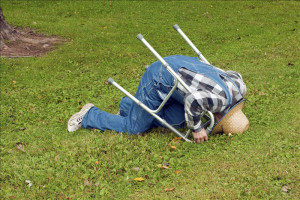Falling is one of the most debilitating problems an elder adult can face. Presently nearly 90% of hip fractures in the elderly population are due to falling. Sadly, nearly 1 in every 5 elder adults who fracture a hip will die within one year due to complications from the injury. Implementing strategies to avoid falling and injury is one of the most important things you can do for yourself and your loved ones. As part of aging successfully and gracefully, strive to maintain your independence and functional mobility as long as possible.
Falling and the fear of falling cause a downward spiral of mobility and independence among the elderly. This affects a person’s quality of life and significantly increases end of life health care costs. A lack of mobility is a major contributor to poor health status. More health care dollars are spent as the person continues to become sicker with chronic diseases such as diabetes, heart disease, congestive heart failure (CHF), chronic obstructive pulmonary disease (COPD), and cancer. These conditions should be (in part) managed through exercise as medicine along with a healthy diet.
8 Easy Strategies to Limit the Risk of Falling:
- Keep walkways clear and free from clutter. Many falls are avoidable simply by cleaning up the areas we frequently walk through.
- Remove throw rugs or at the very least, tack them down so they are less of a trip hazard.
- Add adequate lighting that is easy and convenient to turn on/off from your destination location (such as your bed or recliner). Put the light source on a remote control or clap on/off switches so that you don’t have to walk in the dark from the light switch to your destination.
- Drink more water. Many falls are due to dizziness caused by dehydration. The older you are, the easier it is to become dehydrated. Drinking more water not only prevents dehydration, but it also aids in preventing urinary tract infections (UTI). A UTI can cause weakness, dizziness, and confusion in the elder adult; thus, increasing the risk of falling.
- Use assistive devices correctly. Many people don’t use their canes or walkers appropriately. This can make the device a trip hazard and also increases the risk of falling. If you are unsure how to correctly use an assistive device, please ask a physical therapist for instruction.
- Stay active. Many older adults become less active over time. This occurs for a variety of reasons, but muscle weakness and debility can develop very quickly. A daily walking program or participating in a Tai Chi class can be excellent methods in maintaining balance and mobility while decreasing the risk of falling. I also highly encourage weight training in older adults as muscle atrophy is a major cause of debility and frailty. You are never too old to strength train. The benefits of strength training are noticeable regardless of age.
- Work on your balance. Like muscle, balance can be a use it or lose it proposition. Balance is affected by many of the body’s systems. A quick daily balance routine can greatly reduce your risk of falling. Please refer to the following resources to get started: How Do I Improve Balance? (Part I), How Do I Improve Balance? (Part II), and Improving Balance by Using a Water Noodle.
- Seek help from a physical therapist. Many physical therapists specialize in geriatric care and balance disorders. Treatment options are available in a clinic setting or in the home. Physical therapists can provide care directly in a client’s home. Most health insurance will cover the service if ordered by a medical physician. Physical therapy can provide a great benefit in addressing risk factors for falling. This may include a home evaluation, a physical assessment, and treatment recommendations. In most cases, a treatment plan should include a balance and strengthening component. Thankfully, you can benefit from physical therapy no matter your age. My oldest client was 102 years old. She progressed from being bed bound to being transferred (while using a lift) to walking over 100 feet with assistance!
Most falls are preventable if you are proactive. Implementing these 8 easy strategies will significantly reduce your risk of falling. A fall can significantly and permanently alter your ability to care for yourself and function independently. Broken Hips: Preventing A Fall Can Save Your Life is an excellent NPR article, including an audio clip, that really drives home the importance of this issue. Make changes today for a better tomorrow!
Have you or a loved one been injured from a fall? Which strategy can you implement to reduce your risk of falling? Please leave your comments below.
If you have a question that you would like featured in an upcoming blog post, please comment below or submit your question to contact@thePhysicalTherapyAdvisor.com. Be sure to join our growing community on Facebook by liking The Physical Therapy Advisor!

